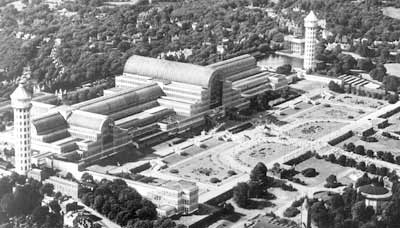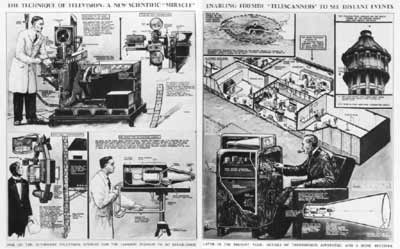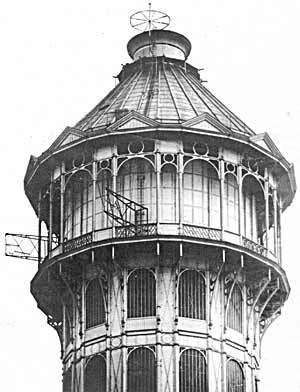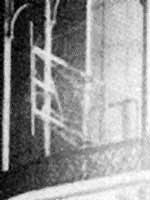|
Part 1 of 3 of a syndicated article by
Richard G Elen <next>
John Logie Baird moved to Sydenham in 1933
and Baird Television Limited moved from Long Acre to the Crystal Palace in July
1933. Of particular interest to Baird, BTL and their new technical director,
former BBC and EMI engineer Captain A D G West – and presumably the main
reason for moving there – was the southern of the two water towers 1068
feet apart at either end of the site.
Built by Isambard Kingdom Brunel, the towers were 275
feet high and afforded an extensive view for miles around – and the South
Tower was an ideal location for VHF transmissions, which are essentially
line-of-sight. VHF or better is necessary to get the required bandwidth for
high-definition television images.
Aerials at the top of the tower, 680 feet above sea
level and in sight of seven counties, were installed to transmit
high-resolution pictures, and the company transferred its experimental GPO
licences from other locations.
To avoid any potential political problems, the GPO
actually consulted the BBC on the transfer: the BBC's Sir John Reith approved
as long as nothing was broadcast that looked like a public, independent TV
service. He was to be disappointed.
|

Above: South area of the
Crystal Palace site showing sections occupied by BTL (after Herbert [1]). 1:
Antennas for short-wave transmission, South Tower (also see below). 2: 2-metre
antenna (1938-9). 3: First floor: original transmitter (1933) 4: Ground floor:
colour TV studio (1937-9) 5: Main studio, office and lab area under south
transept overlooking the terrace (1933-6).

Above: The entire
complex from the air (both images are from a mid-30s postcard, evidently taken
after the renovations of 1933 that left the towers white). The Rotunda is in
the far lower right and the School of Arts is centre-bottom of the picture in
the extreme southeast wing (see text).
|
BTL leased 40,000 square feet under the south
transept, installing offices, studios and laboratories, and a vision
transmitter on the first floor of the South Tower. Later the Rotunda and space
in the School of Arts were leased, bringing the total space up to 60,000 square
feet.
Thanks to funding from Gaumont-British, these
facilities were extensive and ultimately employed over 380 people - indeed they
were arguably more comprehensive in their capabilities than the 1936 Baird
installation for the BBC at Alexandra Palace, which was no doubt built on the
Crystal Palace model.
|

The Illustrated London
News in 1935 printed a plan of the Crystal Palace facility and drawings of
Baird's television technology. Click
<here> to open a new
window with a larger version of this drawing.
|
Unknown to most members of the public, there were
three full-size studios, the largest, Studio 1, being 60 x 40 feet in size,
plus telecine and a small Spotlight Studio for continuity. A central control
room looked out over all three main studios, with Studio 1’s Intermediate
Film camera on the floor below.
The Intermediate Film Technique used a cine camera and
17.5 mm film (split 35 mm), which was developed in just under a minute and
scanned with a flying spot.
On September 12, 1933, Baird demonstrated 120-line, 25
frames per second telecine equipment at the British Association’s annual
meeting, and later that month 120-line test transmissions were made from
Crystal Palace on wavelengths around 6.25 metres (48MHz).
|

|
Left: The top of the South Water Tower in 1935-6. The
antennae visible at the balcony level are for the original 6m sound and vision
transmitters, while the assembly at the very top is for the 1934 10kW VHF
vision transmitter. |
|
Below: close-up of one of the dipoles. (Photos
courtesy of Ray Herbert.)
 |
<click here
to read part 2>
|